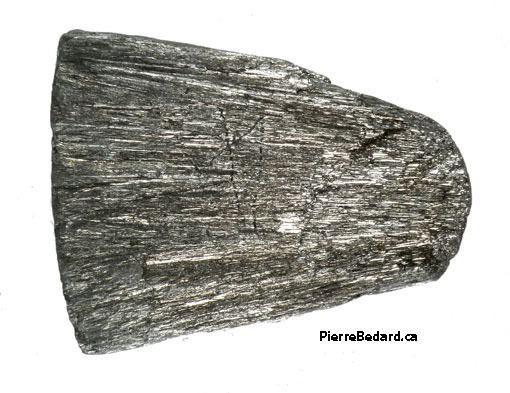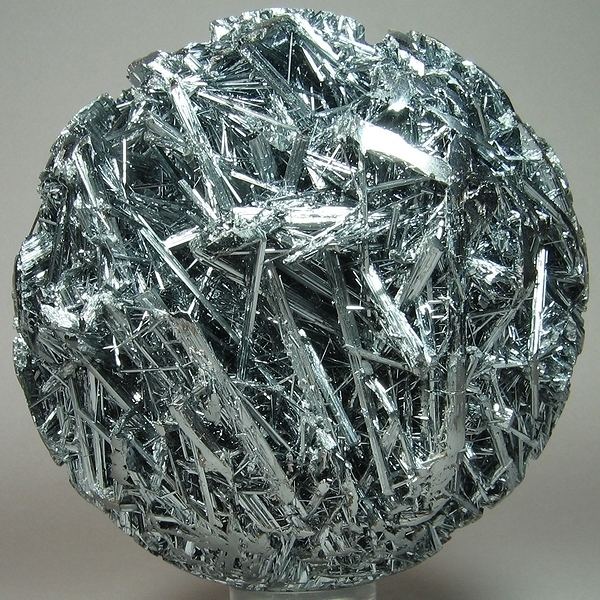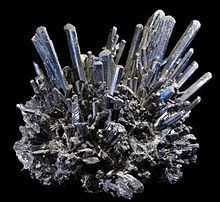Appearance Colourless gas Formula SbH3 Density 5.48 g/cm³ | Boiling point -17 °C Molar mass 124.784 g/mol | |
 | ||
Related compounds | ||
Stibine is a chemical compound with the formula SbH3. A pnictogen hydride, this colourless gas is the principal covalent hydride of antimony, and a heavy analogue of ammonia. The molecule is pyramidal with H–Sb–H angles of 91.7° and Sb–H distances of 170.7 pm (1.707 Å). This gas has an offensive smell like hydrogen sulfide (rotten eggs).
Contents

Preparation
SbH3 is generally prepared by the reaction of Sb3- sources with H+ equivalents:
2 Sb2O3 + 3 LiAlH4 → 4 SbH3 + 1.5 Li2O + 1.5 Al2O34 SbCl3 + 3 NaBH4 → 4 SbH3 + 3 NaCl + 3 BCl3Alternatively, sources of Sb3− react with protonic reagents (even water) to also produce this unstable gas:
Na3Sb + 3 H2O → SbH3 + 3 NaOHProperties

The chemical properties of SbH3 resemble those for AsH3. Typical for a heavy hydride (e.g. AsH3, H2Te, SnH4), SbH3 is unstable with respect to its elements. The gas decomposes slowly at room temperature but rapidly at 200 °C:
The decomposition is autocatalytic and can be explosive.
SbH3 is readily oxidized by O2 or even air:
SbH3 exhibits no basicity, but it can be deprotonated:
Uses

Stibine is used in the semiconductor industry to dope silicon with small quantities of antimony via the process of chemical vapour deposition (CVD). It has also been used as a silicon dopant in epitaxial layers. Reports claim the use of SbH3 as a fumigant but its instability and awkward preparation contrast with the more conventional fumigant phosphine.
History
As stibine (SbH3) is very similar to arsine (AsH3), it is also detected by the Marsh test. This sensitive test detects arsine generated in the presence of arsenic. This procedure, developed around 1836 by James Marsh, is based upon treating a sample with arsenic-free zinc and dilute sulfuric acid: if the sample contains arsenic, gaseous arsine will form. The gas is swept into a glass tube and decomposed by means of heating around 250 – 300 °C. The presence of arsenic is indicated by formation of a deposit in the heated part of the equipment. The formation of a black mirror deposit in the cool part of the equipment indicates the presence of antimony.
In 1837 Lewis Thomson and Pfaff independently discovered stibine. It took some time before the properties of the toxic gas could be determined, partly because a suitable synthesis was not available. In 1876 Francis Jones tested several synthesis methods, but it was not before 1901 when Alfred Stock determined most of the properties of stibine.
Safety
SbH3 is an unstable flammable gas. It is highly toxic, with an LC50 of 100 ppm in mice.
Toxicology
For the toxicology of other antimony compounds, see Antimony trioxide.The toxicity of stibine is distinct from that of other antimony compounds, but similar to that of arsine. Stibine binds to the haemoglobin of red blood cells, causing them to be destroyed by the body. Most cases of stibine poisoning have been accompanied by arsine poisoning, although animal studies indicate that their toxicities are equivalent. The first signs of exposure, which can take several hours to become apparent, are headaches, vertigo, and nausea, followed by the symptoms of hemolytic anemia (high levels of unconjugated bilirubin), hemoglobinuria, and nephropathy.
